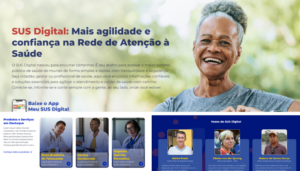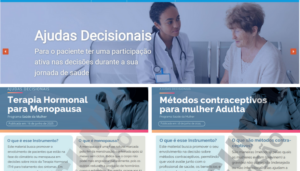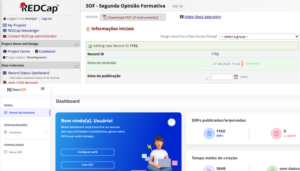The first half of 2025 marked a period of progress for three strategic initiatives developed under the TC157 technical cooperation agreement, led by BIREME/PAHO/WHO in partnership with the Secretariat of Information and Digital Health (SEIDIGI/MS): Brazil’s Unified Health System – SUS Digital Platform; Decision Aids; and Second Formative Opinion. These actions combine technological innovation, participatory methodologies, and service integration that contribute to SUS’ digital transformation.
SUS Digital Platform
The development of the SUS Digital Platform has advanced in terms of its design and structure, represented in a prototype, which was submitted to a usability survey with participants at the 38th Congress of the National Council of Municipal Health Secretariats (CONASEMS), held in Belo Horizonte, MG, Brazil, with a view to aligning user expectations and needs.
Moreover, a workshop was held on July 23rd to design the flows and processes for building and updating the Platform’s sections. This workshop also reviewed the architecture, design, and language of the texts presenting the Platform’s products and sections based on the prototype.
With the collaboration of the SEIDIGI teams, an inventory of products, services, documents, and materials related to SUS Digital was initiated, which allowed for the definition of the taxonomy and configuration of the content management system for the Repository, which includes the description and indexing of different types of content (multimedia, publications, tools, apps, websites, educational resources, news, experience reports, etc.). The registration of 264 initiatives presented at the first Seminar on Digital Transformation at SUS, which took place in November 2024, was also initiated.
For the sections of the platform dedicated to highlighting experiences, reports, and perspectives of different actors in the health system – “SUS Transformation Stories” and “SUS Voices” – proof of concept and validation of templates is underway based on two pilot themes: Telehealth in the Maré Complex and Telehealth in indigenous and quilombola territories.
These initiatives reinforce the role of the SUS Digital Platform as a living space for valuing and sharing transformative digital practices in the Brazilian healthcare system, as well as being a major hub for actions, initiatives, networks, projects, products, and services related to the SUS Digital Program.
“There is a large collection of data, documents, and experiences available to be transformed into indexed content and made available on the SUS Digital Platform, contributing not only to communication and dissemination, but also to the recording and preservation of history, as well as to expanding access to and use of telehealth services by the most vulnerable populations in Brazil,” stated Verônica Abdala, Information Products and Services Manager, who leads the project at BIREME.

Decision Aids Tools
Those are tools that assist in health decision-making, enabling health users and care providers to make informed and shared decisions. The project for the development of Decision Aids (DA) within SUS has made significant progress, such as its institutional structuring, methodological definition, and the collaborative building of the first DA prototypes.
The Steering Committee and the Scientific and Technical Committee were formed, national and international exchanges were held, and the mapping of existing DAs was completed. The first version of the Standard Operating Procedure (SOP) was also drafted, and frameworks were developed to guide the creation of prototypes.
Four DAs prototypes were developed collaboratively, involving the definition of thematic areas, the formation of teams of specialists, the conduct of searches for systematic review, and the conduct of interviews and focus groups with users of the health system and services.
The themes include contraceptive methods for adult women; contraceptive methods for adolescents; hormone replacement therapy during menopause; and childbirth methods. The prototypes, consolidated in PDF format, are in the final stages of review for the application of the “alpha test” – a stage that will assess the clarity, comprehensibility, and feasibility of using the DAs, both from the perspective of patients and health professionals.
In July, the second co-creation workshop was held in Brasilia to consolidate the DAs, bringing together experts, managers, and representatives of social movements. The meeting validated the methodology, structure, and scientific basis of the DAs, in addition to defining the planning for the alpha test. At the same time, progress was made in the creation of the DA Portal, which will be integrated into the SUS Digital Platform, expanding the reach, usability, and visibility of the product.

Second Formative Opinion
The Second Formative Opinion (SOF) project has made significant progress, consolidating strategic and institutional steps to update the service. A Steering Committee was formed, requirements were surveyed, and the first version of the SOF management system was developed on a provisional platform (REDCap). The SOF template and workflow were reviewed and updated, and a concept test involving six telehealth centers and thirteen professionals was conducted.
A co-creation workshop was also held for the new SOF, focused on defining operational processes and migrating the database with more than 1,700 SOFs to the REDCap system, with the submission, review, and publication features already implemented. Version 2 of the management system (SOFNet) and the new SOF portal integrated with the SUS Digital Platform are under development, in addition to the creation of a prototype interface for integration with instant messaging applications.
The next steps include defining the SOF production flow with different entry routes and expanding the network of collaborators for the creation, review, and updating of SOFs, as well as making version 2.0 of the system available, with full functionality.
